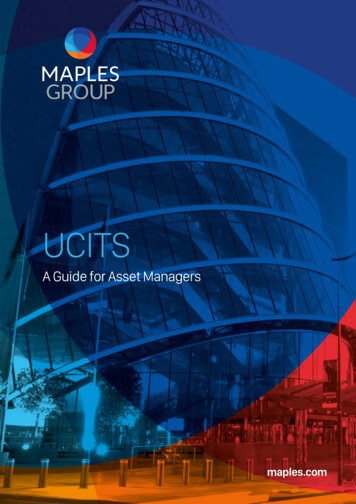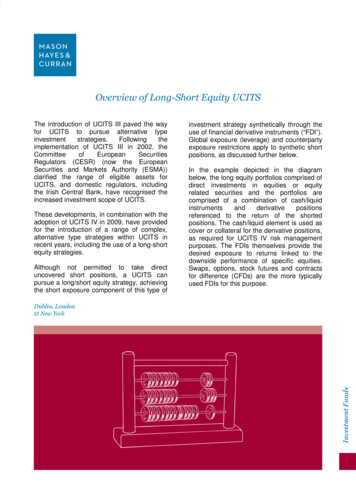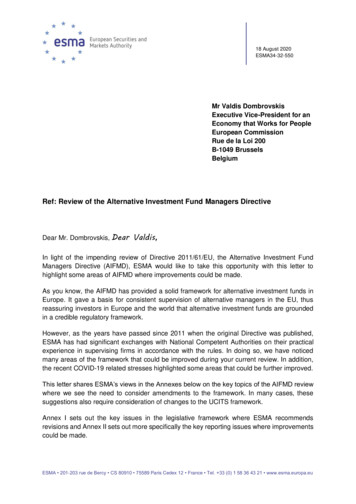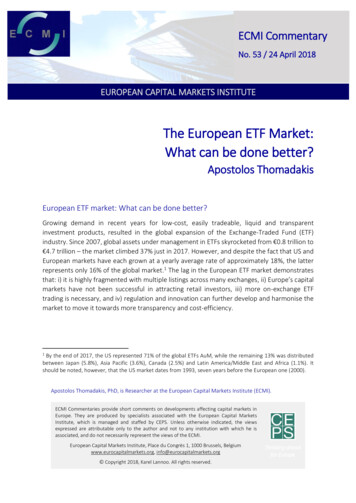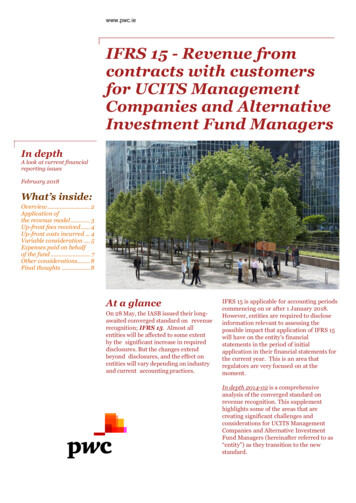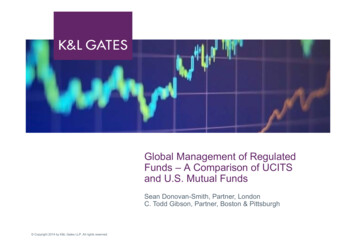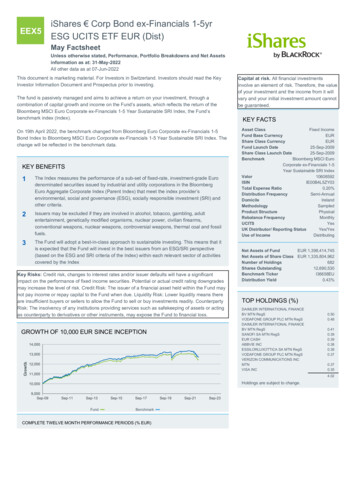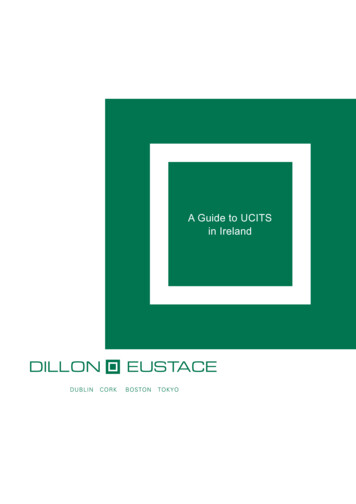
Transcription
A Guide to UCITSin Ireland
ContentsA Guide to UCITS in Ireland1. IntroductionPage 32. Legislative Basis for UCITS in IrelandPage 53. Overview of UCITS Permitted Asset Classesand Investment and Borrowing RestrictionsPage 94. Transferable Securities and Money Market InstrumentsPage 135. UCITS Money Market FundsPage 196. Index Tracking UCITSPage 237. UCITS investing in other Collective Investment SchemesPage 258. UCITS investing in Financial Derivative InstrumentsPage 319. UCITS investing in Derivatives on Financial IndicesPage 4110. Available Legal StructuresPage 4511. UCITS Management Companies/SMICsPage 5112. UCITS IVPage 5713. Taxation of UCITS in IrelandPage 6114. UCITS Authorisation ProcessPage 6515. Ongoing Supervision and General Regulatory RequirementsPage 6916. Appendices- A. Definitions: Transferable Securities of Money Market InstrumentsPage 73- B. UCITS Investment and Borrowing RestrictionsPage 80- C. UCITS Management Company Authorisation OptionsPage 8917. Contact UsPage 91
1Introduction
A GUIDE TO UCITSIN IRELAND1. IntroductionUndertakings for Collective Investment inTransferable Securities, commonly referred toas UCITS, are collective investment schemesestablished and authorised under a harmonisedEuropean Union (EU) legal framework underwhich a UCITS established and authorisedin one EU Member State can be sold crossborder into other EU Member States without arequirement for an additional authorisation. Thisso-called “European passport” is central to theUCITS product and enables fund promoters tocreate a single product for the entire EU ratherthan having to establish an investment fundproduct on a jurisdiction by jurisdiction basis.Originally introduced over twenty years ago,UCITS have become the gold standard EUinvestment fund product, recognised not onlyby the European financial services communitybut also further afield with many non-EUjurisdictions accepting UCITS as suitable forretail sale into their domestic markets. Whilstsold across the full spectrum of investor types,UCITS have been designed principally for theretail market as open-ended diversified, liquidproducts with their parameters - permittedasset classes and investment and borrowingrestrictions - being enshrined in EU law.governance requirements being introduced in2002 and clarified in 2007 and with a seriesof additional changes now envisaged underthe UCITS IV proposal having as their aim afurther simplification of the European passportprocess for UCITS, the use of master/feedertype structures, the creation of a framework forcross-border fund mergers and the replacementof the Simplified Prospectus. UnderpinningUCITS and the proposed future evolutions ofthe product has been a common EU approachwith involvement from securities regulators andindustry participants across the European Unionat each stage of the development process.Whilst at times the pace of change may be toofast for some and too slow for others, to dateUCITS has generally achieved the right balance.Ireland has become one of the leading EU“exporting” jurisdictions for UCITS having beenpro-active in implementing the UCITS regimeinto domestic legislation in 1989, introducinga sensible investment funds focused fiscalregime and clear but prudential process forthe authorisation and supervision of UCITSand relevant service providers. The resulthas been that promoters from all acrossthe world have and continue to use Irelandas a domicile of choice for UCITS productsseeking to access the European marketplace and, in many cases, further afield.Importantly, UCITS is not a product which hasstood still, rather it has and continues to evolve,most recently with a significant broadeningof permitted asset classes and more robustPAGE 3
2Legislative Basisfor UCITS in Ireland
2. Legislative Basis forUCITS in IrelandThe legislative basis for UCITS in Ireland isfounded on European law implementeddomestically, expanded upon by UCITS relatednotices issued by the Irish Financial Regulator(the “UCITS Notices”) and with furtherclarification provided for in a series of FinancialRegulator guidance notes (“Guidance Notes”)each of which – European and domesticlegislation and the UCITS Notices andGuidance Notes – have evolved and beenamended over time.(i) European LegislationThe original UCITS Directive (Directive85/611/EC) of 1985 established theUCITS product as a pan-Europeancollective investment scheme whichbenefited from an EU-wide passport basedon the concept of mutual recognition ofHome State authorisation, setting down thelegal forms which UCITS could take, theirpermitted investment and borrowing rules,liquidity requirements, prospectus disclosurerules and rules relating to annual andsemi-annual reporting as well as rulesrelating to the role and duties of UCITScustodians/depositaries and theirmanagement companies.Whilst amended in 1988 (Directive88/220/EEC) in a limited fashion to increasemaximum permitted investments in certaintypes of bonds issued by credit institutions,in 1995 (post-BCCI Directive 95/26/EC) andin 2000 (Directive 2000/64/EC) with regardto exchange of information with thirdcountries, no substantive change to theUCITS product was made until 2002 withthe introduction of the UCITS ManagementCompany Directive (Directive 2001/107/EC)and the UCITS Product Directive (Directive2001/108/EC), the Management Companyand Product Directives referred to generallyas “UCITS III”.UCITS III represented a major overhaul ofUCITS in terms of what they could invest in,how they could be offered and sold and howthey were to be managed.Given the experience of the original UCITSregime and an often inconsistent, asbetween EU Member States, application ofits terms, the introduction of UCITS III wasfollowed by the creation of CESR, theCommittee of European SecuritiesRegulators, which was requested to adviseon the interpretation of terms used withinUCITS III with the aim of achieving acommon agreed position on its interpretationand application. Following a series ofconsultations, CESR issued its final advicesin January, 2006, followed in March, 2007by a European Commission implementingDirective (Directive 2007/16/EC), referred toas the Eligible Assets Directive, which wasin turn accompanied by CESR guidelinesconcerning UCITS eligible assets.(ii) Irish LegislationThe original 1985 UCITS Directive (asamended) was implemented into domesticIrish law by the European Communities(Undertakings for Collective Investment inTransferable Securities) Regulations, 1989(the “1989 UCITS Regulations”).PAGE 5
The 1989 UCITS Regulations were amendedin 1996 (S.I. No. 357/1996), in 1999 (S.I.No. 50/1999) and in 2003 (S.I. No. 51/2003)and were then revoked and replaced, in thecontext of domestic implementation of UCITSIII, by the European Communities(Undertakings for Collective Investment inTransferable Securities) Regulations (S.I. No.212/2003) (as amended by S.I. No. 213 of2003) (the “2003 UCITS Regulations”).Supervisory requirements for UCITSauthorised by the Financial Regulatorand certain firms providing services tosuch UCITS – UCITS 2.Subsequently amended by S.I. No. 497/2003,by the Central Bank and Financial ServicesAuthority Act, 2004 (introduction of a singleregulator for financial services in Ireland), bythe Investment Funds, Companies andMiscellaneous Provisions Act, 2005(introduction of segregated liability forumbrella investment companies) and byS.I. No. 832/2007 (implementation of EligibleAssets Directive), the present legislativebasis for UCITS in Ireland is encompassed inthe 2003 UCITS Regulations (as amended).Prospectus – UCITS 6.(iii) UCITS NoticesThe Irish Financial Regulator has issued aspecific set of UCITS Notices which explainand clarify various aspects of the UCITSRegulators and which set down conditionsnot contained within the UCITS Regulationswith which Irish UCITS are required toconform.These UCITS Notices deal with:Information and document requirementsof the Financial Regulator in support ofan application for authorisation as aUCITS – UCITS 1.PAGE 6Trustees – eligibility criteria – UCITS 3.Trustees – duties and conditions – UCITS 4.General conditions – UCITS 5.Information to be included in the monthlyreturns – UCITS 7.Publication of annual and half-yearlyreports – UCITS 8.Eligible Assets and Investmentrestrictions – UCITS 9.Financial derivative instruments – UCITS 10.Borrowing powers – UCITS 11.Techniques and Instruments includingRepurchase/Reverse Repurchase andStock lending for the purposes of efficientportfolio management– UCITS 12.Umbrella UCITS – UCITS 13.Dealings by promoter, manager, trustee,investment adviser and group companies– UCITS 14.Supervisory requirements for UCITSauthorised in another Member Stateintending to market their units in Ireland– UCITS 15.
Code of conduct in relation to collectiveportfolio management – UCITS 16.Capital Compliance Requirement –Guidance and regulatory report.We refer to certain of these Notices inparticular throughout this document.(iv) Financial Regulator Guidance Notesand Policy DocumentsThe Financial Regulator has additionallyissued a series of Guidance Notes whichprovide further clarification on the FinancialRegulator’s approach on particular issuesand has also issued a number of specificpolicy documents.Certain Guidance Notes have applicationto all regulated fund types (both UCITSand Non-UCITS) such as those dealingwith fund promoters, permitted markets forretail schemes, multi-adviser schemes,Money Market Funds, valuation rules, etc.,with others having specific UCITSapplication such as those dealing withUCITS investing in other collectiveinvestment schemes, with UCITS investingin Financial Derivative Instruments, withthe Simplified Prospectus, with UCITSinvesting in Financial Indices and withUCITS prospectus disclosures forStructured Products and ComplexTrading Strategies.PAGE 7
3Overview of UCITSPermitted Asset Classesand Investment andBorrowing Restrictions
3. Overview of UCITS PermittedAsset Classes and Investmentand Borrowing Restrictions(i) Permitted Asset ClassesWhilst dealt with in greater detail in followingsections, UCITS are in summary permittedto invest in:transferable securities and moneymarket instruments which are eitheradmitted to official listing on a stockexchange in an EU Member State ornon-EU Member State or which aredealt on a market which is regulated,operating regularly recognised andopen to the public;recently issued transferable securitieswhich will be admitted to official listingon a stock exchange or other market(as described above) within a year;money market instruments, other thanthose dealt in on a regulated marketprovided that the issue or the issuer isitself regulated for the purpose ofprotecting investors and savings;units of UCITS and units of non-UCITScollective investment schemes (CIS)(in certain cases);deposits with credit institutions; andfinancial derivative instruments thatmeet certain criteria; andtransferable securities and moneymarket instruments other than thosereferred to above (subject to a maximumaggregate limit of net asset value).Given the increased investmentopportunities granted under UCITS IIIand the subsequent clarification of the terms“transferable securities” and “money marketinstruments”, UCITS provide for a verybroad spectrum of fund types andexposures, from relatively plain vanillaequity and bond products through to UCITStaking exposures to hedge fund andcommodities indices, with UCITS fund offunds, money market and cash funds andindex replicators also provided for.(ii) Investment and BorrowingRestrictionsYou will find the standard UCITS investmentand borrowing restrictions set out inAppendix B. In the following sections furtherdetail is given on the application of thoseinvestment and borrowing restrictions,taking account of how the FinancialRegulator has interpreted and/or appliesthose restrictions, in the context of particulartypes of UCITS products.In summary, however, it is important to note:that the principal UCITS focus is onportfolio diversification and liquidity;the general “5/10/40” rule requiring thatno more than 10% of a UCITS netassets may be invested in transferablesecurities or money market instrumentsissued by the same body, with a furtherPAGE 9
aggregate limitation of 40% of net assetson exposures of greater than 5% to singleissuers;that there are exceptions to the abovefor investments issued or guaranteed bygovernments, local authorities or certainpublic international or supra-nationalbodies;that index replicators can takeexposures up to 20% of net assets tosingle issuers, with up to 35% to a singleissuer in exceptional market conditions;that up to 100% of net assets can beinvested in other collective investmentschemes (CIS), provided no more than20% invested in any one CIS, with anaggregate restriction of 30% of netassets applying to investment in nonUCITS CIS as well as strict rulesapplying to the nature of CIS in which aUCITS can invest, as well as limitinginvestment to a maximum of 25% of theunits of the underlying CIS;that no more than 20% of net assets canbe invested in cash deposits with anyone credit institution as permitted by theFinancial Regulator and up to 10% ofnet assets may be held for ancillaryliquidity purposes with other creditinstitutions (which 10% limit is raised to20% in the case of deposits made withthe custodian/trustee);that investments in/through derivativesmay be made/taken to assets in towhich a UCITS can invest directlyPAGE 10including financial instruments havingone or several characteristics of thoseassets, and to financial indices, interestrates, FX rates and currencies;that the maximum exposure to a singleOTC derivative counterparty is 5%,increasing to 10% for certain creditinstitutions;that various aggregations of the aboverestrictions apply (see Appendix B forfurther detail);that the maximum aggregate exposureto securities/instruments (other thanCIS, derivatives and cash) not listed ortraded on a recognised market is 10% ofnet assets;that additional general provisions applyincluding concentration limits,prohibitions on taking legal/managementcontrol of issuers, prohibitions onuncovered sales; andthat borrowings are limited to 10% of netassets and can only be used fortemporary purposes (for liquidity).(iii) Efficient Portfolio ManagementTechniques and InstrumentsUCITS are permitted to use techniquesand instruments relating to transferablesecurities and money market instrumentsfor efficient portfolio management (EPM)purposes which is taken to mean that theyare economically appropriate and areentered into with the aim of reducing risk,
reducing cost or generating additionalcapital or income (with a level of riskconsistent with the UCITS risk profile).Derivatives used for EPM purposes mustcomply with normal rules for investment infinancial derivative instruments.Repos/Reverse Repos and stocklendingare expressly permitted with strict rulesregarding collateral including acceptableforms of collateral, level provided, valuationof collateral and how and where held andmaintained. There are also strict rules asto counterparty credit rating (A2 orequivalent or deemed implied ratingof A2) or indemnification.PAGE 11
4Transferable Securitiesand Money MarketInstruments
4. Transferable Securities andMoney Market Instruments(ii) Clarification by Eligible AssetDirectiveAs the UCITS acronym suggests, its originalfocus was on investment in “transferablesecurities” although as you will note from thefollowing sections UCITS do offer far widerinvestment possibilities. Additionally a primaryUCITS focus has been on “money marketinstruments”. Although the full definitions ofboth terms are set out in Appendix A, we havehighlighted the key elements of both below,particularly given the clarifications provided in2007 by the Eligible Assets Directive.In 2007 the Eligible Assets Directiveclarified the above definition by providingthat the reference to transferable securities“shall be understood as a reference tofinancial instruments which fulfil thefollowing criteria”:A. Transferable Securities(b) their liquidity does not compromisethe ability of the UCITS to comply withits obligation to provide at leastfortnightly redemption facilities;(i) UCITS III DefinitionsWhilst not defined in the original 1985UCITS Directive, the UCITS III ProductDirective did introduce a definition of theterm “transferable securities” as being:shares in companies and othersecurities equivalent to shares incompanies (“shares”);bonds and other forms of securitiseddebt (“debt securities”);other negotiable securities which carrythe right to acquire any suchtransferable securities by subscriptionor exchange;other than the permitted UCITS efficientportfolio management (EPM) techniquesand instruments.(a) the potential loss which the UCITSmay incur with respect to holding thoseinstruments is limited to the amount paidfor them;(c) reliable valuation is available for themas follows:(ii) in the case of securities admitted toor dealt in on a regulated market inthe form of accurate, reliable andregular prices which are eithermarket prices or prices madeavailable by valuation systemsindependent from issuers;(iii) in the case of other securities [i.e.the aggregate 10% that can beinvested in transferable securitiesand money market instrumentsnot specifically referred to in Article19(1)], in the form of a valuation ona periodic basis which is derivedPAGE 13
from information from the issuerof the security or from competentinvestment research;principles regarding consideration of orpresumption of negotiability.(iii) Closed Ended Funds(d) appropriate information is available forthem as follows:(i) in the case of securities admittedto or dealt in on a regulated marketas referred to in subparagraphs (a)to (d) of Article 19(1), in the form ofregular, accurate and comprehensiveinformation to the market on thesecurity or, where relevant, on theportfolio of the security;(ii) in the case of other securities asreferred to in Article 19(2), in theform of regular and accurateinformation to the UCITS on thesecurity or, where relevant, onthe portfolio of the security;(e) they are negotiable;(f) their acquisition is consistent with theinvestment objectives or the investmentpolicy, or both, of the UCITS;(g) their risks are adequately capturedby the risk management processof the UCITS.It is worth noting that liquidity is a centralrequirement for UCITS portfolios and,accordingly, there are broad principles laiddown regarding presumptions as to liquidity,assessment of liquidity risk whereinformation is available which suggestsredemption facilities could be compromisedby a transferable security as well asPAGE 14The Eligible Assets Directive has made itclear that certain closed-ended funds will fallwithin the “transferable securities” definitionand therefore be eligible for investment byUCITS where:(i) they fulfil the criteria set out in “(ii)Clarification by Eligible Assets Directive”above;(ii) they are subject to corporategovernance mechanisms applied tocompanies or equivalent to those appliedto companies;(iii) they are managed by an entity which is(or where asset management activity iscarried out by another entity on behalf ofthe closed ended fund, that entity is)subject to national regulation for thepurpose of investor protection.Appendix A sets out some of the principlesused in considering the equivalenceof corporate governance mechanisms forcontractual type closed-ended funds.A UCITS may not make investment inclosed ended funds for the purposesof circumventing the normal UCITSinvestment limits.(iv) Structured Financial InstrumentsStructured financial instruments can alsobe eligible for investment as “transferable
securities” where they are financialinstruments which:(i) they have a maturity of issuance of up toand including 397 days;(i) fulfil the criteria set out “(ii) Clarificationby Eligible Assets Directive” above;(ii) they have a residential maturity of up toand including 397 days;(ii) are backed by, or linked to theperformance of, other assets, whichmay differ from those referred to inArticle 19(1); provided that where afinancial instrument covered by thissubparagraph contains an embeddedderivative component, the requirementsregarding the derivatives riskmanagement process, global exposureand aggregation of direct and indirectexposures shall apply to thatcomponent.(iii) they undergo regular yield adjustmentsin line with money market conditions atleast every 397 days;(iv) their risk profile, including credit andinterest rate risks, corresponds to that offinancial instruments which have amaturity as referred to in subparagraphs(i) or (ii), or are subject to a yieldadjustment as referred to insubparagraph (iii).(ii) Instruments which are liquidB. Money Market InstrumentsThe term “money market instruments” refersto instruments normally dealt in on themoney market which are liquid, and have avalue which can be accurately determinedat any time. UCITS can invest in moneymarket instruments admitted to trading/dealtin on a regulated market and in moneymarket instruments which are not admittedto or dealt in on a regulated market.(i) Instruments normally dealt in on theMoney MarketThe reference to money market instrumentsas “instruments normally dealt in on themoney market” shall be understood as areference to financial instruments which fulfilone of the following criteria:The reference to money market instrumentsas “instruments which are liquid” shall beunderstood as a reference to financialinstruments which can be sold at limitedcost in an adequately short time frame,taking into account the obligation of theUCITS to repurchase or redeem its units atthe request of any unit holder.Appendix A sets down the factors to betaken into account at both the instrumentand fund level in assessing liquidity.(iii) Instruments which have a valuewhich can be accurately determinedat any timeThe reference to “money market instrumentsas instruments which have a value whichcan be accurately determined at any time”PAGE 15
shall be understood as a reference tofinancial instruments for which accurate andreliable valuations systems, which fulfil thefollowing criteria, are available:(a) they enable the UCITS to calculate anet asset value in accordance with thevalue at which the financial instrumentheld in the portfolio could be exchangedbetween knowledgeable willing partiesin an arm’s length transaction;(b) they are based either on market data oron valuation models including systemsbased on amortised costs.With respect to the criterion “value whichcan be accurately determined at any time”,if the UCITS considers that an amortisationmethod can be used to assess the value ofa money market instrument, it must ensurethat this will not result in a discrepancybetween the value of the money marketinstrument and the value calculatedaccording to the amortisation method asset out in Guidance Note-/08 UCITS:Valuation of assets of money market funds.More detail on liquidity requirementsand on governmental issues and issuesby securitisation vehicles can be foundin Appendix A.PAGE 16
PAGE 17
5UCITS Money MarketFunds
5. UCITS Money Market FundsWhilst many UCITS will invest principally inmoney market instruments and may considerthemselves to be money market funds, thereare only certain funds which are permittedby the Financial Regulator to refer to “moneymarket funds” in its title and to follow anamortised cost valuation methodology. Suchmoney market funds must be established asconstant NAV Funds or accumulating NAV fundswith the principal objective to preserve principaland maintain liquidity. Further, only those moneymarket funds which have obtained a triple Arating from an internationally recognised ratingagency together with a supplementary marketrisk rating (for example AAm by Standard &Poors or Aaa/MR1 by Moodys) or which havemanagement companies/investment managerswith demonstrable expertise in the operation ofmoney market funds (which use amortised costvaluation) can use the term money market fundor UCITS money market fund in their title andfollow an amortised cost valuation methodology.Other types of money market funds may notuse the term money market fund in their titleand must value assets on a mark to marketbasis in accordance with the valuation rulesset out by the Financial Regulator in itsGuidance Note 1/00.In this section we deal only with the former typeof money market fund.(i) Key ConditionsA number of conditions apply to moneymarket funds which use the amortised costvaluation methodology as follows:Eligible Assets: assets must be restrictedto cash or high-quality money marketinstruments;Maturity: assets are restricted to securitieswhich comply with one of the followingcriteria:(a) have a maturity at issuance of up to andincluding 397 days;(b) have a residual maturity of up to andincluding 397 days; and(c) undergo regular yield adjustments inline with money market conditions atleast every 397 days; and/or(d) the risk profile, including credit andinterest rate risk, correspond to that offinancial instruments which have suchmaturities or yield adjustments.In the case of (c) and (d) above, the moneymarket instruments invested in must alsomeet with the final maturity requirements ofthe relevant rating agency.WAM: the weighted average maturity of theportfolio must not exceed 60 days;Mark to Market: a weekly review ofdiscrepancies between market valueand amortised cost value of money marketinstruments must be carried out withescalation procedures being put in placeto ensure that material discrepanciesare brought to the attention of investmentmanagement personnel with discrepanciesin excess of 0.1% being broughtPAGE 19
to the attention of senior managementwithin the management company orboard of directors, the investment managerand trustee/custodian and if discrepanciesin excess of 0.3% occur then a dailyreview must take place with themanagement company/directors notifyingthe Financial Regulator of the discrepanciesand indicating what action, if any, will betaken to reduce the dilution.Stress Testing: a monthly portfolio analysisis required to be carried out incorporatingstress testing to examine portfolio returnsunder various market scenarios todetermine if portfolio constituents areappropriate to meet predetermined levelsof credit risk, interest rate risk, market riskand investor redemptions and this periodicanalysis must be available for inspection bythe Financial Regulator.(ii) ECB Reporting RequirementsMoney market funds are required toprovide a variety of monthly and quarterlydata through the Financial Regulator forthe purpose of European Central Bankreporting requirements. Guidance NoteGN2/99 sets out the relevant requirementsinto which money market funds theobligations apply.PAGE 20
PAGE 21
6Index Tracking UCITS
6. Index Tracking UCITSOne of the cornerstones of UCITS since theintroduction of the original UCITS Directivein 1985 has been the imposition of strictrisk spreading requirements. This has beenenshrined in what is commonly known asthe 5/10/40 rule which is that a UCITS mayinvest no more than 10% of its net assetsin transferable securities or money marketinstruments issued by the same body, providedthat the total value of transferable securitiesor money market instruments held in issuingbodies in each of which it can invest morethan 5% is less than 40%.This fundamental UCITS principle did createproblems for UCITS which wished to track anindex where the weighting of a constituentelement of the index exceeded the 5% limit orwhere the relationship between two or moreconstituent elements of the index meant thatthey were considered to constitute a singleissuer resulting in an aggregation of theexposure.(i) 20% and 35% RuleSince the introduction of a UCITS III, UCITSwhose policy is to replicate an index is nowpermitted to invest up to 20% of net assetsin shares and/or debt securities issued bythe same body, with the 20% limit beingraised up to 35% in the case of a singleissuer where justified by exceptionalmarket conditions. This flexibility ispermitted where the relevant index isrecognised by the Financial Regulatoron the basis that it is sufficiently diversified,it represents an adequate benchmark forthe market to which it refers and it ispublished in an appropriate manner.(ii) Index ReplicationThe reference to “replication” of thecomposition of a shares or debt securitiesindex is considered by the FinancialRegulator to mean replication of thecomposition of the underlying assets ofthe index including the use of derivativesor other permitted UCITS efficient portfoliomanagement techniques and instruments.(iii) Sufficient DiversificationAlthough somewhat circular, reference toan index’s composition being diversifiedrefers to an index which allows for amaximum weighting per issuer of 20% witha capacity for a single constituent to exceed20% but not exceed 35% of the index.(iv) Adequate BenchmarkThe reference to the index representingan adequate benchmark for the market towhich it refers is a reference to an indexwhose provider uses a recognisedmethodology which generally does notresult in the exclusion of a major issuerof the market to which it refers.(v) PublicationThe requirement that the index be publishedin an appropriate manner is taken as areference to an index which is accessibleto the public and where the index provider isindependent from the index replicatingUCITS. Note, however, that this secondrequirement does not preclude indexproviders and the UCITS forming part ofthe same economic group provided thateffective arrangements for the managementof conflicts of interest are in place.PAGE 23
7UCITS Investing in OtherCollective InvestmentSchemes
7. UCITS Investing in OtherCollective InvestmentSchemesUCITS are permitted to invest up to 100%of their assets in other open-ended collectiveinvestment schemes (“CIS”) where thoseCIS are:other UCITS; orother
broad spectrum of fund types and exposures, from relatively plain vanilla equity and bond products through to UCITS taking exposures to hedge fund and commodities indices, with UCITS fund of funds, money market and cash funds and index replicators also provided for. (ii) Investment and Borrowing Restrictions
